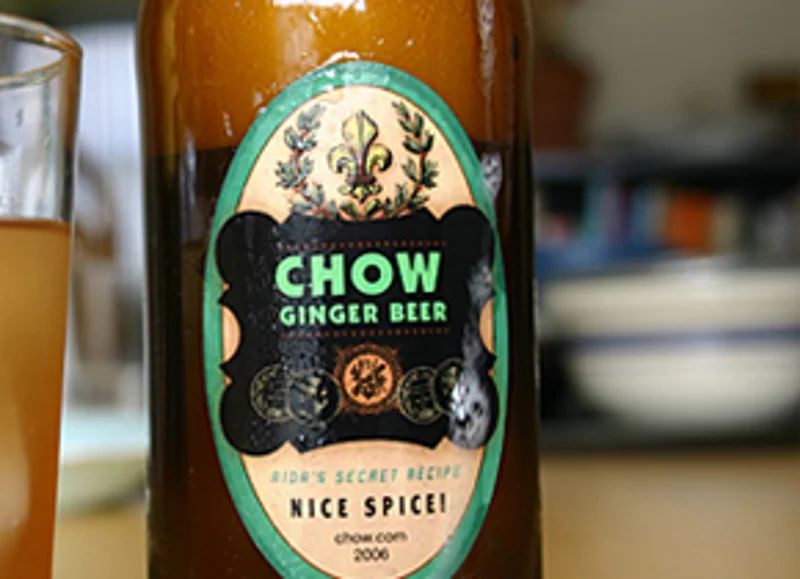This is a recipe for making ginger beer from scratch (that is, with natural yeast), so of course we can’t guarantee that it is going to work, because the yeast needs to do its job to start the bug, or culture. We got it to work quite a few times, though, so with some patience and persistence you have good odds.
Special equipment: You can buy a special ginger grater, but unless you are going to be using it on an almost daily basis, we think it is more practical to get the affordable and multipurpose zester from Microplane.
You can find cheesecloth at most grocery stores and kitchen supply shops.
A fine-mesh strainer is a useful kitchen tool.
Use an instant-read digital thermometer for this recipe.
Look for bottling equipment at a craft-brewing supply store. You can also buy the equipment online from San Francisco Brewcraft.
- 4 large (22-ounce) dark glass crown-cap or bail-top bottles
- 4 bail tops (if using bail-top bottles)
- 4 new metal crown caps (if using plain bottles and caps), plus more for mistakes
- 1 wing bottle capper (if using plain bottles and caps)
- 1 small plastic water bottle (around 16 ounces)
- 1 small funnel
- 1 large funnel
- 1 (5-gallon) bucket
- A bottle brush
- A clean dishtowel
Game plan: Be sure to have your bottling equipment already in the sterilizing solution before you begin making your ginger beer.
Naturally fermented sodas like this one produce light carbonation, so there’s little risk of your bottles exploding. However this can occur, so we encourage you to store the bottles somewhere where it would be OK if that happened, such as an unused bathtub.
This recipe was featured as part of our Make Your Own Soda Pop project. While the brew is incredible as-is, we recommend trying to in our easy dark and stormy recipe.
- Yields: 4 (22-ounce) bottles plus 1 test bottle (about 3 quarts)
- Difficulty: Medium
- Total: 45 mins, plus 13 to 18 days for the bug, bottling, and fermentation
- Active: 45 mins, plus bottling 45 Ratings
Ingredients (4)
- 1 piece fresh ginger (about 6 inches long)
- 1 cup turbinado sugar
- 12 cups distilled water
- 2 medium lemons
Instructions
For the bug:
- Combine 1 teaspoon grated ginger (unpeeled), 1 teaspoon turbinado sugar, and 1 cup distilled water in a small bowl. Stir, cover with cheesecloth, and leave in a room-temperature area (70°F to 75°F works best). Add another teaspoon of ginger and sugar every other day until the bug becomes active (it should take 6 to 8 days). The bug is active once there are a few bubbles on the surface and a white residue forms on the bottom of the bowl.
For the ginger beer:
- Halve the lemons and juice them, reserving both the juice and the rinds. In a large pot, combine 1 quart (4 cups) distilled water with 2 teaspoons grated ginger (about 2 inches), the remaining turbinado sugar (should be a scant cup), the juice of the lemons, and the lemon rinds and bring to a boil over high heat. Let this mixture boil for 15 minutes and then remove from heat. Discard the lemon rinds.
- Add the remaining 7 cups distilled water and let the mixture cool to room temperature (about 70°F to 75°F). Pour through a fine mesh strainer into a large, clean pot. Then strain the bug into the pot (stir before straining to make sure that the white residue gets included). Mix to combine, and now you’re ready to bottle.
- Set the sealed ginger beer bottles upright to ferment at room temperature (about 70°F to 75°F works best) in an area where it is OK if the bottles explode (such as a bathtub). Let the soda ferment for about 7 to 10 days. Around day 7, test the flavor and carbonation of the ginger beer by sampling the test bottle. (Note: We fermented the soda for about 8 days and were happy with the balance of sugar and ginger at that point. The longer you let the soda ferment, the more sugar the yeast will consume, and therefore the less sugary the soda will be.) When the soda is ready, place the labels on the bottles and put the bottles in the refrigerator to halt the fermentation process. Make sure the bottles are completely cold prior to opening.

